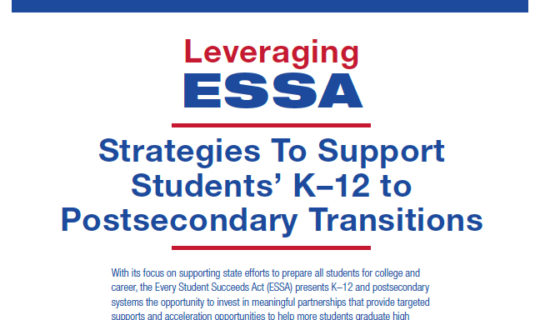Free college. It’s now a reality for high school graduates in New York and Rhode Island, which recently joined Tennessee, Oregon, Minnesota and more than 200 communities in instituting “college promise” programs to help any high school graduate who qualifies pay for college.
These promises are highly attractive educationally, economically and politically. They remove what is one of the most significant barriers for the student who’s seeking a post-secondary certificate or degree – cost – and open doors to lifelong economic prosperity. They also help states and communities meet their workforce needs. That’s why nearly half of states considered legislation funding some form of free college in the past year. As promise programs gain favor in statehouses and city halls, though, it’s important that political leaders not neglect college preparation in the name of increasing access. Otherwise, these initiatives risk being empty promises.
Far too many of America’s youth struggle to make the transition from high school to college. Many of those that do clear that hurdle end up in the black hole of remedial education. Of students enrolled in remedial coursework at two-year colleges, only 1 in 10 will attain a degree. We can do much better by ensuring that states’ K-12 and post-secondary systems work together to improve college readiness without the need for remediation.
Funding a promise program without ensuring college readiness is like a mayor announcing she’s opening a free golf course in every neighborhood. Only problem is, too few residents have golf clubs or know how to play.
To make the most of college promise programs, two things must change:
Every high school student needs a college readiness intervention. We have to use the 12th grade to make sure every potential college promise recipient is academically prepared for success in postsecondary education. States and communities with promise programs need a complementary “speed-up” and “catch-up” strategy to create frictionless transitions for students. For students that are on track to college, let’s accelerate their progress by enrolling them in advanced courses that provide postsecondary credit. For those behind, let’s address their gaps in a 12th-grade transition course that certifies them as “college-ready” before they step foot on campus. Tennessee provides a model bringing K-12 and higher education together to offer early postsecondary options and collaboratively develop a 12th-grade transition course that, with passage, guarantees placement in credit-bearing coursework upon matriculation.
No college student should be enrolled in a standalone remedial course. If we are currently batting 10 percent with incoming community college freshmen in standalone remedial courses, let’s not repeat our swing, especially for students receiving promise scholarships. We need a new approach. One that has shown early promise is the co-requisite model of remediation. Institutions such as Austin Peay State University, Community College of Baltimore County and Georgia Gwinnett College are enrolling students directly into credit-bearing core courses and providing supplemental supports alongside. Student success rates are up significantly as a result. Based on the success of the early implementers, Texas recently passed legislation making co-requisite remediation the required model for students placing into developmental education courses. States with promise programs should follow their lead.
Delivering on the promise of college promise programs may require new investment or reallocation of existing resources, but these two support strategies more than pay for themselves in reduced remedial costs and increased attainment rates. Tennessee estimates its investment in the 12th-grade transition course has saved students more than $60 million.
States and communities that have launched college promise programs deserve great praise. They are removing barriers that have long stood in the way of college access for many of our nation’s most underserved students. Now they must complete the deal and keep the promise by addressing the preparation gap that threatens the long-term success of the program.
Matt Gandal
President, Education Strategy Group
Note: This piece was originally published in U.S. News and World Report.







